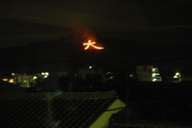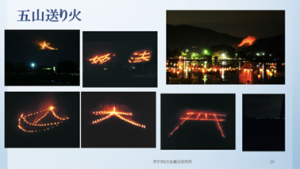Gravity(Attraction) of Kyoto 13 Intangible assets of a long-established company: unique to Kyoto
Yoshie Doi
 |
 |
Every year on August 16th in Kyoto, the Gozan no Okuribi fires are held to mark the end of the Obon festival. The history of the Gozan no Okuribi is said to be around 500 years old, dating back to the Muromachi period, but after the Meiji Restoration, when Western civilization was introduced, the Gion Festival, which exorcises the god of plague, and the Gozan no Okuribi, which sends off the spirits of ancestors, were considered superstitions and were banned for 10 years.
There are various theories about the origins of the Gozan no Okuribi, and it is not clear which is correct. According to the commonly held belief, on the night following Obon, there was a custom of throwing torches into the sky to see off the spirits passing through the void, and it is said that the Gozan no Okuribi originated from this custom, which was lit on the mountain and fixed in the air.
The idea that when a person dies, their soul leaves their body, ascends to the peak of a mountain, and over the course of many years becomes a mountain god was influenced by Buddhism and developed into the idea of mountain pure land. The Gozan no Okuribi bonfire ceremony is still held today to light the path for the spirits that return during Obon to the afterlife.
It is said that during Obon, ancestors will ride on chopsticks stuck into cucumbers and eggplants to return home. The cucumber is said to be fast like a horse, while the eggplant cow is said to be a spirit horse that returns slowly, carrying a souvenir story to tell.
There is a teaching called Ulabone that was introduced from China. Mokuren Sonja, a disciple of Buddha, used his supernatural powers to search for his deceased mother and found her suffering in the realm of Gakido (hungry devil). He tried to bring her food, but everything had turned to ashes and he was unable to deliver it. He asked Buddha for advice, and he was told to give food and offerings to monks who were completing their training on July 15th, and that such offerings would save his mother.
This is the origin of the Obon memorial service. This charity will save the ancestors, and the idea that the ancestors will return during Obon was added to it, and the tradition became established in Japan.
Although some people now mistake Gozan no Okuribi for a tourist event, it is a sacred Buddhist ritual. It only lasts for one day, and is only lit for 20 minutes, but preparations take a whole year to complete. Watching the flickering flames for 20 minutes marks the end of summer in Kyoto.
”Fire has the meaning of purification. Since the Muromachi period, we have lit fires to purify the bodies of many people who have died in wars and other events. If the fire were not lit, we don’t know what would happen to Kyoto,” says one member of the preservation society. We would like to express our gratitude to all the members of the preservation society who pray for good health and freedom from disease by keeping the fire lit.
I have heard that even this year, with its extreme heat, they are having trouble every year procuring pine wood for burning. Pine needles are also used. Pine needle resin contains essential oils and has a high calorie content when burned. The wood used for the Gozan no Okuribi varies depending on the mountain, and the color of the fire also seems to vary.
Kyoto’s long-established stores have many Gozan no Okuribi products, including Japanese sweets, tsukudani (food boiled in soy sauce), sencha (green tea), tenugui (hand towels), folding fans, uchiwa (traditional Japanese rings), dinner shows, and tours. Classic Japanese sweets exclusive to Kyoto are especially popular. Many products are sold as souvenirs and offerings. An event unique to Kyoto produces products unique to Kyoto.
The end of document
Translated by Masami Otani
